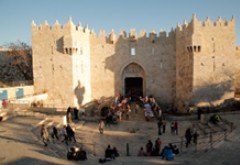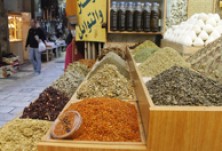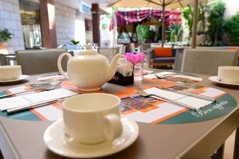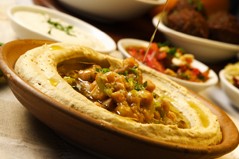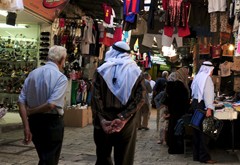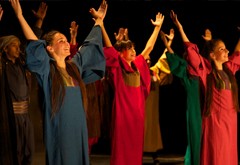Meaning of al-‘Imara al-‘Amira
The term al-‘Imara’ al-‘Amirais a Turkish word meaning a building that provides food for the poor and strangers, particularly soup. In Jerusalem, it was known as Khassaki Sultan or Takiya Khassaki Sultan. The word ‘Takiyya is originally the Turkish word of ‘Tekke’ referring to a Sufi establishment.
North Entrance
Al-‘Imara al-‘Amira complex is very large. It has two entrances, the north of which is next to the east entrance of the al-Sitt Tunshuq Palace and comprises a trefoil arch , framed by ogee moulding . Above the entrance is a straight lintel, with the key stone (middle stone) decorated by a multi-layered flower similar to the one at the entrance of the Khaasaki Sultan Takiyya in Aksaray, Istanbul.
The difference in the style of construction between al-Sitt Tunshuq Palace and al-‘Imara al-‘Amira is evident here. The palace belonged to the Mamluk school of architecture, while al-‘Imara al-‘Amira belonged to the Ottoman one. The north entrance gives access to a hall that leads into an open courtyard, divided into two parts on the basis of the floor’s elevation. This part of al-‘Imara al-‘Amira contains the kitchen, storage, a water fountain, and a building of two floors, with the bakery in one of the rooms of the lower floor.
South Entrance
The south entrance (see access above) comprises a large arch similar in shape and decorations to Bab al-‘Amud. It leads to a transitional area known as Dirkah, richly decorated with circular stonework and leading to an open courtyard surrounded by arcades that form the Khan or caravansary of the al-‘Imara al-‘Amira. To the east of the Khan and its open courtyard is a building known as al-‘Adliyya, which was established in the 19th century. Indeed, al-‘Imara al-‘Amira is a huge architectural project that comprises four open courtyards, several staircases, several composite buildings, some with two floors, and a set of rooms and halls of various sizes and construction styles.
Founder
The wife of Sultan Suleiman al-Kanuni (Suleiman I) initiated the construction of the al-‘Imara al-‘Amira. The original name of Khassaki Sultan is Roxalana, because Khaasaki is a nickname given to the beloved woman of the sultan, giving her a higher rank than all the sultan’s concubines and slaves. She was also known by the name of Khurm, which has several meanings, including the joyful one, the laughing one, and the happy one. It appears that she had such qualities,beauty, intelligence and personality that she managed to convince the sultan not only to release her from her slavery but also to marry her. It is said that the sultan remained faithful to her from the day they met and until her death.
Architectural Units of al-‘Imara al-‘Amira
The structure’s units, as indicated by the Waqf document, include a large Khan for travelers and merchants, a mosque with domes and arches, a Ribat comprising 55 rooms for Sufis and the poor, a large kitchen with an bakery and a mill, several storage areas, and a water fountain with fresh water for the residents and for cooking. Most of these units, with the exception of the Ribat and the mosque, remain standing and can be seen today.
Food Conditions and Quantities
Khassaki Sultan was keen on the food menu and the conditions of distributing it. She dictated that two types of soup must be cooked every day. The first was a rice soup for lunch, including the following ingredients: rice (16.380 kg), claified butter (2.457 kg), chickpeas (1.228 kg), onions (1.638 kg), salt (2.047 kg), yoghurt (20.475 kg); and parsley equal to four dirhams, while 49.14 kg of firewood was used to cook the soup. The second soup was a wheat soup (Freekeh) for dinner (except on Friday nights) and it included the following ingredients: wheat (14.212 kg), claified butter (2.457 kg), salt (2.047 kg), onions (1.638 kg), cumin (0.614 kg), and chickpeas (1.228 kg), while 57.33 kg of firewood was used to cook the soup. Each day, 2,000 loaves of bread were made, each weighing 281.25 grams, meaning that around 562.5 kg of wheat, 2.457 kg of salt, and 45.045 kg of firewood were used daily. This is a simple example of what used to be cooked in this charity establishment. It is fortunate that the Takiyya is still operating and serves soup, rice and meat to residents of the Old City, particularly during the Holy Month of Ramadan.

